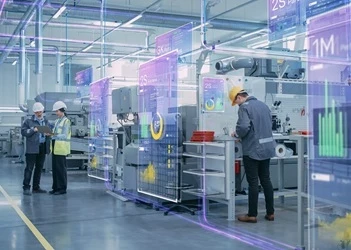Why the workflow automation journey should begin with understanding the customer needs
Linford Dailey, global digitalization and automation leader at Bosch, speaks with PEX Network about his experience to date and what he expects from the future of automation
Add bookmark
Linford Dailey, global digitalization and automation leader at global machinery manufacturing organization Bosch, discusses his extensive experience with workflow automation and reflects on some of the successes he has experienced throughout his career. Dailey gives his top advice for workflow automation practitioners, shares his predictions for the future of automation and offers an overview of what he will cover in his session at PEX Live: Workflow Automation 2022.
discusses his extensive experience with workflow automation and reflects on some of the successes he has experienced throughout his career. Dailey gives his top advice for workflow automation practitioners, shares his predictions for the future of automation and offers an overview of what he will cover in his session at PEX Live: Workflow Automation 2022.
PEX Network: Can you tell us about your experience with workflow automation and share some success stories?
Linford Dailey: I started working with automation in 2005 at Procter & Gamble, handling various initiatives that eliminated a lot of steps in invoice processing. I was evaluating different processes or improvement opportunities in the tax department. I automated the month-end closing process, reducing the time it took us to reconcile tax accounts from six days to only two days.
I had further success when I moved on to Amway, as we were able to improve some of the transfer pricing methodologies and add in some automation, making sure that we could certify the pricing that we were working with.
We were also able to reduce the amount of errors we experienced across our 150,000 stock-keeping units by approximatively two to three per cent on an annual basis review which resulted in less than 0.1 per cent error. We eliminated 1,000 to 2,000 item issues from one year to another which reduced the amount of training for our people.
At Bosch we started our automation journey with robotic process automation (RPA) four to five years ago. I first applied it to invoice processing to help reduce man-hours. Now, we are automating the entire process for credit management and it has reduced a significant amount of manual work. Aside from this we have also been working on automating the cash application and the billing process.
Currently I am responsible for the development of more than 300 bots at Bosch. We are combining different technologies to help us drive great savings such as machine learning and artificial intelligence. We even have bots that run for more than 20 hours a day at a global scale, .
PEX Network: What is your top advice for organizations looking to implement workflow automation?
LD: Businesses need to understand the customers’ experience and needs first and identify where the pain points are coming from. Once customer needs and pain points are understood, only then should businesses begin selecting the right tools to use for each of those pain points, rather than just implementing a number of technologies in attempts to reach their targets.
If businesses focus only on the implementation of technologies to reach these targets, they may be successful but not at the rate they expected. Finally, businesses should be looking into how these initiatives could be driving them into new business models.
PEX Network: What key developments do you see happening in workflow automation over the next few of years?
LD: We are beginning to see the future of workflow automation in what is happening currently. We can see that automation is most likely going to be moving from mimicking human actions to mimicking the thinking of the human brain.
We are now moving toward automation for deciding how we will transform our data. In the future we could have automated recommendations for how we actually take the data and transform it into the next product for our customers.
PEX Network: Finally, what can attendees expect to learn from your session on defining the value of low-code and no-code?
LD: One of the biggest takeaways that I will try to give the audience is that we need to generate a systematic approach in how to reach our goals with automation. I primarily recommend trying to understand the user experience, and that means not just giving a wide variety of tools and solutions to employees but rather understanding what the customer needs are and how the users operate to meet them.
What I really want to get across to the audience is that when you automate, you are not losing people, you are gaining new business models. I want them to understand that we need to move into the next era, which is not the one of the automated processes as many believe, as we are already in that era. The next era is the era of generating new jobs, so that the existing, experienced staff are not given away to competitors.
I also want to emphasize that when we are collecting data we should be acting on it rather than stocking it into an Excel file and saving it in someone's folder. We need to take that information, add value to it and use it to generate insights and business opportunities. We are not automating for the sake of it, we are automating to transform the business.
To hear Dailey’s advice on low-code, no-code and achieving end-to-end process transformation, register for both of his sessions at PEX Live: Workflow Automation 2022.
Do you agree with Dailey’s predictions regarding the future of workflow automation? Let us know in the comments below.
















